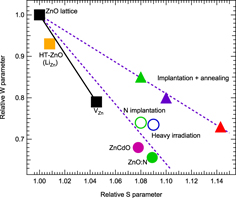Crossref Citations
This article has been cited by the following publications. This list is generated based on data provided by
Crossref.
Jiang, M.
Xue, X. D.
Chen, Z. Q.
Liu, Y. D.
Liang, H. W.
Zhang, H. J.
and
Kawasuso, A.
2014.
Defects and acceptor centers in ZnO introduced by C+-implantation.
Journal of Materials Science,
Vol. 49,
Issue. 5,
p.
1994.
Azarov, A. Yu.
Hallén, A.
Du, X. L.
Rauwel, P.
Kuznetsov, A. Yu.
and
Svensson, B. G.
2014.
Effect of implanted species on thermal evolution of ion-induced defects in ZnO.
Journal of Applied Physics,
Vol. 115,
Issue. 7,
Yao, Zhengrong
Gu, Shulin
Tang, Kun
Ye, Jiandong
Zhang, Yang
Zhu, Shunming
and
Zheng, Youdou
2015.
Zinc vacancy related emission in homoepitaxial N-doped ZnO microrods.
Journal of Luminescence,
Vol. 161,
Issue. ,
p.
293.
Tang, Kun
Gu, Ran
Gu, Shulin
Ye, Jiandong
Zhu, Shunming
Yao, Zhengrong
Xu, Zhonghua
and
Zheng, Youdou
2015.
Annealing in tellurium-nitrogen co-doped ZnO films: The roles of intrinsic zinc defects.
Journal of Applied Physics,
Vol. 117,
Issue. 13,
McCluskey, Matthew D.
2015.
Defects in Semiconductors.
Vol. 91,
Issue. ,
p.
279.
Gautam, Subodh K.
Singh, R.G.
Siva Kumar, V.V.
and
Singh, Fouran
2015.
Giant enhancement of the n-type conductivity in single phase p-type ZnO:N thin films by intentionally created defect clusters and pairs.
Solid State Communications,
Vol. 218,
Issue. ,
p.
20.
Makkonen, Ilja
Korhonen, Esa
Prozheeva, Vera
and
Tuomisto, Filip
2016.
Identification of vacancy defect complexes in transparent semiconducting oxides ZnO, In2O3 and SnO2.
Journal of Physics: Condensed Matter,
Vol. 28,
Issue. 22,
p.
224002.
Tang, Kun
Gu, Shulin
Ye, Jiandong
Zhu, Shunming
Zhang, Rong
and
Zheng, Youdou
2016.
High-quality ZnO growth, doping, and polarization effect.
Journal of Semiconductors,
Vol. 37,
Issue. 3,
p.
031001.
Singh, Aditya Narayan
2016.
Positron annihilation spectroscopy in tomorrow's material defect studies.
Applied Spectroscopy Reviews,
Vol. 51,
Issue. 5,
p.
359.
Yao, Zhengrong
Tang, Kun
Xu, Zhonghua
Ye, Jiandong
Zhu, Shunming
and
Gu, Shulin
2016.
The Luminescent Inhomogeneity and the Distribution of Zinc Vacancy-Related Acceptor-Like Defects in N-Doped ZnO Microrods.
Nanoscale Research Letters,
Vol. 11,
Issue. 1,
Yao, Zhengrong
Tang, Kun
Ye, Jiandong
Xu, Zhonghua
Zhu, Shunming
and
Gu, Shulin
2016.
Identification and control of native defects in N-doped ZnO microrods.
Optical Materials Express,
Vol. 6,
Issue. 9,
p.
2847.
Johansen, K.M.
Tuomisto, F.
Makkonen, I.
and
Vines, L.
2017.
Formation of Zn- and O- vacancy clusters in ZnO through deuterium annealing.
Materials Science in Semiconductor Processing,
Vol. 69,
Issue. ,
p.
23.
Tang, Kun
Gu, Ran
Zhu, Shunming
Xu, Zhonghua
Shen, Yang
Ye, Jiandong
and
Gu, Shulin
2017.
Optical fingerprints of donors and acceptors in high-quality NH_3-doped ZnO films.
Optical Materials Express,
Vol. 7,
Issue. 4,
p.
1169.
Tang, Kun
Gu, Shu-Lin
Ye, Jian-Dong
Zhu, Shun-Ming
Zhang, Rong
and
Zheng, You-Dou
2017.
Recent progress of the native defects and p-type doping of zinc oxide.
Chinese Physics B,
Vol. 26,
Issue. 4,
p.
047702.
Tang, Kun
Gu, Ran
Zhu, Shunming
Xu, Zhonghua
Ye, Jiandong
and
Gu, Shulin
2017.
Thermal evolution of zinc interstitial related donors in high-quality NH_3-doped ZnO films.
Optical Materials Express,
Vol. 7,
Issue. 2,
p.
593.
McCluskey, Matthew D.
2018.
Defects in Advanced Electronic Materials and Novel Low Dimensional Structures.
p.
1.
Yao, Zhengrong
Tang, Kun
Xu, Zhonghua
Ma, Jingrui
Ye, Jiandong
Zhu, Shunming
and
Gu, Shulin
2018.
The suppression of zinc interstitial related shallow donors in Te-doped ZnO microrods.
Journal of Alloys and Compounds,
Vol. 735,
Issue. ,
p.
1232.
Yao, Zhengrong
Tang, Kun
Xu, Zhonghua
Ma, Jingrui
and
Gu, Shulin
2019.
Synthesis and properties of tellurium-nitrogen co-doped ZnO micro-/nano-rods.
Optical Materials Express,
Vol. 9,
Issue. 2,
p.
652.
Wang, Zilan
Luo, Caiqin
Anwand, W.
Wagner, A.
Butterling, M.
Rahman, M. Azizar
Phillips, Matthew R.
Ton-That, Cuong
Younas, M.
Su, Shichen
and
Ling, Francis Chi-Chung
2019.
Vacancy cluster in ZnO films grown by pulsed laser deposition.
Scientific Reports,
Vol. 9,
Issue. 1,
Bazioti, Calliope
Azarov, Alexander
Johansen, Klaus M.
Svensson, Bengt G.
Vines, Lasse
Kuznetsov, Andrej Y.
and
Prytz, Øystein
2019.
Role of Nitrogen in Defect Evolution in Zinc Oxide: STEM–EELS Nanoscale Investigations.
The Journal of Physical Chemistry Letters,
Vol. 10,
Issue. 16,
p.
4725.





